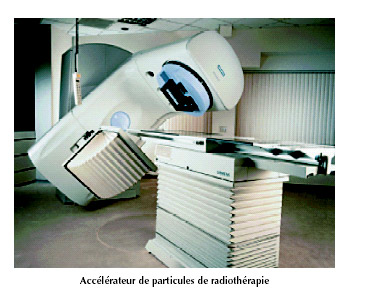X-rays but no radioactivity
Radiotherapy today denotes all cancer treatments based on ionizing radiation, without distinguishing the origin of this radiation, atomic (X rays), nuclear or particle produced by accelerators.
It is not possible to distinguish an X-ray photon from a gamma having the same energy, nor an atomic electron from a beta electron expelled by a nucleus. Biological and therapeutic effects are the same, whatever the origin of the radiation or particle. However, the techniques can vary depending on the radiation source:

Small accelerators used in radiotherapy
In teleradiotherapy, small linear accelerators are used in order to provide gamma rays or electrons whose energies are higher than the gamma rays emitted by a cobalt 60 source: up to 30 MeV instead of 1 MeV. Besides the advantage of higher and adjustable energy, accelerators are used to direct the rays on the tumor with much higher accuracy. In 2003, there were already currently 260 eleradiotherapy accelerators.
© ASN 2003 Report
For example, one can use sources external to the patient: it is the case of teletherapy, a technique widely used today based on energetic X-rays generated by accelerated particles, or on gamma rays emitted by radioactive substances such as cobalt-60 (cobalt « bombs »). These X or gamma rays go through a body part before reaching their target, for example a deep tumor.
Specialized technicians or engineers try, by various techniques (mobile sources around the patient, remote-controlled lead screens allowing a “conformal” radiotherapy adapted to the shape of the tumour, preferential absorption of some radiations at a given depth) to minimize the surface dose and to concentrate the energy deposition in the target.
They also tried, using only radioactive sources, to implant « needles » of radium (now replaced by iridium 192 or gold 198) in the body of a tumor. This is the principle of “brachytherapy » developed early in the twentieth century by Claudius Regaud. Although relatively limited, its use continues today in some cases (like for example capsules of iodine-125 in cancer of the prostate, directly inserted into the tumor tissue).
Finally, it is now possible to have the benefit of all the possibilities made available by the progress done in biology and pathophysiology in order to « associate » a radioactive substance to a metabolism or to a metabolic product, which will then, by-itself, locate and go to the tumor area or nearby. This is the principle of « metabolic therapy ».
These techniques are combined by oncologists with chemotherapy and surgery to define, the most effective therapeutic strategy in each case.
In a near future, a lot of improvements could be expected : in teletherapy, commonly used techniques are now heading toward an extensive use of linear accelerators that deliver at will X-ray photons or accelerated electrons under high energies. In a similar way, nowadays protontherapy is more often used : the proton is a weapon of choice in cell destruction, because it offers the possibility of modulating the proton energy to adjust the dose delivered depending on the depth to reach in the body.
Other articles on the subject « Radiation Therapy »
Metabolic Therapies
Therapeutic Radioisotopes Applications of radioisotopes in nuclear medicine are not limited to sc[...]
Brachytherapies
The oldest nuclear therapy modernized today Brachytherapies (or Curietherapies) are the oldest th[...]
Prostate Brachytherapy
An Efficient destruction of cancerous cells Since the 2000s, particularly in the United States an[...]
Protontherapies
Proton therapy: an advanced and precise radiotherapy Proton therapy involves treating tumors with[...]
Secondary Risks
Alternative: exposure to radiation or let the cancer evolve… For over 20 years, there has b[...]